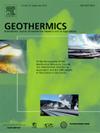基于地热钻井数据的浅层机器学习方法:以美国FORGE油田58-32井为例
IF 3.5
2区 工程技术
Q3 ENERGY & FUELS
引用次数: 0
摘要
增强型地热系统(EGS)的开发依赖于高效的钻井方法。传统的物理驱动数值模拟模型虽然有效,但由于深层储层条件的复杂性,计算量要求很高。相比之下,数据驱动模型通过从训练数据中提取统计特征来创建预测模型,从而提供了一种更简单的方法。该研究利用美国FORGE现场的诊断钻井数据来训练反向传播神经网络(BPNN)和随机森林回归模型。随机森林模型的训练时间为4.981 s,测试R2为0.9995,计算效率比BPNN高91.82%,准确率比BPNN高1.04%。通过使用最大钻速(ROP)、泵压力、扭矩和流量等特征有效解释99.95%的钻井深度值,该模型展示了浅层机器学习在地热能源开发中广泛数据集的潜力。该研究不仅验证了数据驱动模型在优化钻井性能方面的有效性,而且强调了它们在未来钻井项目中降低成本的作用。这些发现为地热行业提供了有价值的见解,为改进钻井策略和改善资源管理铺平了道路。本文章由计算机程序翻译,如有差异,请以英文原文为准。
A shallow machine learning method based on geothermal drilling data: A case study of well 58–32 at the U.S. FORGE site
Enhanced geothermal system (EGS) development relies on efficient drilling methods. Traditional physics-driven numerical simulation models, while effective, are computationally demanding due to the complexity of deep reservoir conditions. In contrast, data-driven models offer a simpler approach by deriving statistical features from training data to create predictive models. This study utilizes diagnostic drilling data from the U.S. FORGE site to train Back Propagation neural network (BPNN) and Random Forest regressor models. The Random Forest model, with a training time of 4.981 s, achieves a test R2 of 0.9995, surpassing the BPNN in computational efficiency by 91.82 % and accuracy by 1.04 %. By effectively explaining 99.95 % of drilling depth values using features such as maximum rate of penetration (ROP), pump pressure, torque, and flow in, the model demonstrates the potential of shallow machine learning on extensive datasets in geothermal energy development. This research not only validates the efficacy of data-driven models in optimizing drilling performance but also highlights their role in cost reduction for future drilling projects. The findings present valuable insights for the geothermal industry, paving the way for enhanced drilling strategies and improved resource management.
求助全文
通过发布文献求助,成功后即可免费获取论文全文。
去求助
来源期刊

Geothermics
工程技术-地球科学综合
CiteScore
7.70
自引率
15.40%
发文量
237
审稿时长
4.5 months
期刊介绍:
Geothermics is an international journal devoted to the research and development of geothermal energy. The International Board of Editors of Geothermics, which comprises specialists in the various aspects of geothermal resources, exploration and development, guarantees the balanced, comprehensive view of scientific and technological developments in this promising energy field.
It promulgates the state of the art and science of geothermal energy, its exploration and exploitation through a regular exchange of information from all parts of the world. The journal publishes articles dealing with the theory, exploration techniques and all aspects of the utilization of geothermal resources. Geothermics serves as the scientific house, or exchange medium, through which the growing community of geothermal specialists can provide and receive information.
 求助内容:
求助内容: 应助结果提醒方式:
应助结果提醒方式:


